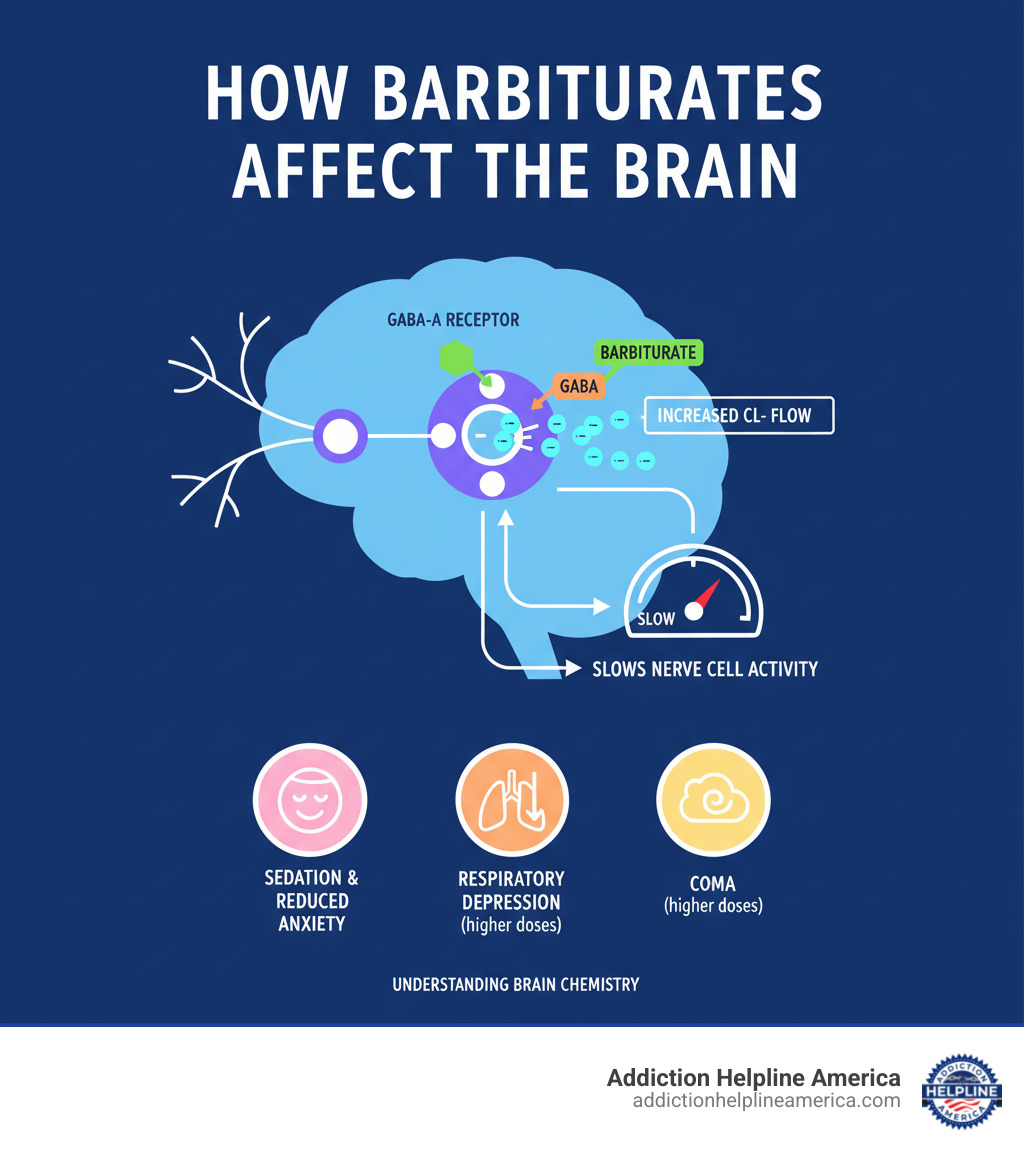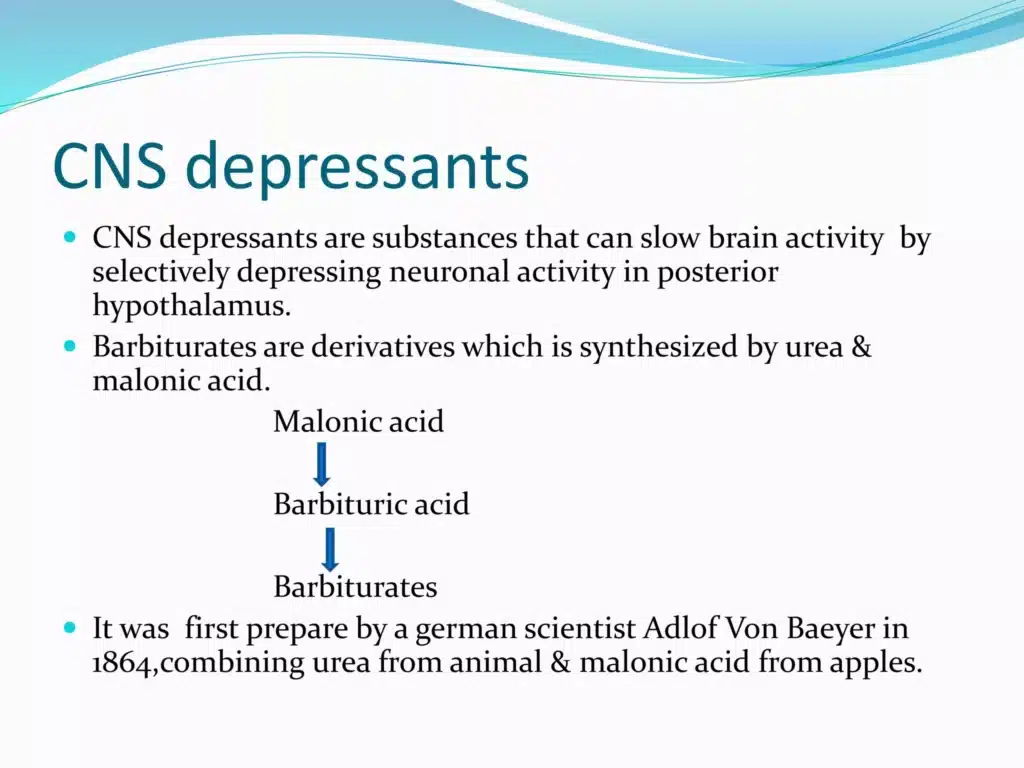
Understanding Barbiturates: A Class of Powerful Depressants
Barbiturates are central nervous system (CNS) depressants. Once common for anxiety, insomnia, and seizures, they were largely replaced by safer options because of their narrow therapeutic window, high overdose potential, and severe withdrawal.
Quick Facts About Barbiturates:
- What they are: Synthetic sedatives that improve the inhibitory neurotransmitter GABA.
- Medical uses: Limited to seizure control (phenobarbital), anesthesia, and select headache meds.
- Common names: Phenobarbital (Luminal), pentobarbital (Nembutal), secobarbital (Seconal), butalbital (Fioricet).
- Street names: Barbs, downers, yellow jackets, red devils.
- Legal status: Controlled substances (Schedule II-IV in the US).
- Major risks: Overdose, rapid tolerance, severe dependence, life-threatening withdrawal.
- Why they declined: Benzodiazepines offer a better safety profile.
At Addiction Helpline America, we know barbiturate use can quickly become dangerous. If you or a loved one is struggling with a substance use disorder, learning about these medications is a powerful first step.

What Are Barbiturates and How Do They Work?
Barbiturates slow brain activity by enhancing the effects of gamma-aminobutyric acid (GABA), the brain’s primary inhibitory neurotransmitter. By increasing the duration that GABA-A receptor chloride channels stay open, they produce strong sedation; at high doses, they can open these channels even without GABA, which explains their overdose risk.
For a deeper scientific perspective, see the research on barbiturate mechanism of action.

What are the different types of barbiturates?
- Ultra-short-acting: Seconds to minutes; anesthesia (methohexital, thiopental).
- Short-acting: 2-4 hours; historically for sleep (pentobarbital, secobarbital).
- Intermediate-acting: 4-6 hours; headache meds (butalbital).
- Long-acting: Over 6 hours; seizure control (phenobarbital).
Common Examples and Their Uses
- Phenobarbital (Luminal): Long-acting anticonvulsant.
- Butalbital: In combination headache medications (Fioricet, Fiorinal).
- Pentobarbital (Nembutal): Severe seizures, pre-surgical sedation.
- Primidone (Mysoline): Converts to phenobarbital; seizures, essential tremor.
- Secobarbital (Seconal): Former sleeping pill; now rarely used.
Why Did Barbiturate Prescriptions Decline?
- Narrow therapeutic window: Small margin between effective and lethal doses.
- Rapid tolerance: Dose escalation without matching safety tolerance.
- Severe dependence/withdrawal: Risk of seizures and medical crises if stopped abruptly.
- Safer alternatives: Benzodiazepines supplanted most uses.
The Dangers and Risks of Barbiturate Use
While medically useful in select cases, barbiturates carry substantial risk because they profoundly depress the CNS.

Key risks include:
- Drowsiness, confusion, and impaired judgment.
- Respiratory depression, especially at higher doses.
- Tolerance and dependence that drive dose escalation.
In comparative analyses of drug harms, barbiturates rank high for physical harm and dependence. For more details, the DEA provides comprehensive data on barbiturates.
Overdose, Polysubstance Use, and Other Risks
Overdose can lead to coma, dangerously slowed or stopped breathing, low blood pressure and temperature, and death. Risk skyrockets when combined with alcohol or opioids due to synergistic CNS depression. If you are struggling with multiple substances, it is vital to find help for alcohol and drug addiction. During pregnancy, exposure may cause neonatal withdrawal.
Key Differences Between Barbiturates and Benzodiazepines
| Feature | Barbiturates | Benzodiazepines |
|---|---|---|
| Mechanism | Increase duration of GABA channel opening; can open channels at high doses. | Increase frequency of GABA channel opening; require GABA to be present. |
| Safety | Narrow therapeutic window; high overdose risk. | Wider therapeutic window; lower overdose risk when used alone. |
| Overdose | Often fatal due to severe respiratory depression. | Rarely fatal unless combined with other depressants. |
| Withdrawal | Extremely dangerous; can be fatal (seizures, cardiovascular collapse). | Serious and requires medical supervision, but generally less life-threatening. |
What Are Barbiturates and How Do They Work?
Barbiturates improve GABA’s inhibitory effect, holding GABA-A chloride channels open longer and powerfully slowing brain activity. At high doses, they can act without GABA, which explains their overdose danger.
For a deeper scientific perspective, see the research on barbiturate mechanism of action.
What are the different types of barbiturates?
- Ultra-short: seconds to minutes (anesthesia).
- Short: 2-4 hours (historical sedatives).
- Intermediate: 4-6 hours (e.g., butalbital in headache meds).
- Long: 6+ hours (e.g., phenobarbital for seizures).
The Dangers and Risks of Barbiturate Use
Barbiturates can impair judgment and breathing and rapidly lead to tolerance and dependence. They are especially dangerous when mixed with alcohol or opioids. In comparative harm rankings, they score high for physical harm and dependence. See the DEA fact sheet for details.
Overdose, Polysubstance Use, and Other Risks
Overdose signs include unresponsiveness, slowed or stopped breathing, low blood pressure and temperature, and coma. Combining with other depressants dramatically increases risk. If you are struggling with multiple substances, find help for alcohol and drug addiction.
Key Differences Between Barbiturates and Benzodiazepines
| Feature | Barbiturates | Benzodiazepines |
|---|---|---|
| Mechanism | Increase duration of GABA channel opening; can open channels at high doses. | Increase frequency of GABA channel opening; require GABA to be present. |
| Safety | Narrow therapeutic window; high overdose risk. | Wider therapeutic window; lower overdose risk when used alone. |
| Overdose | Often fatal due to severe respiratory depression. | Rarely fatal unless combined with other depressants. |
| Withdrawal | Extremely dangerous; can be fatal (seizures, cardiovascular collapse). | Serious and requires medical supervision, but generally less life-threatening. |
Understanding Barbiturates: A Class of Powerful Depressants
Barbiturates are CNS depressants that were widely prescribed before safer medications became available. Their high overdose potential, severe withdrawal, and narrow therapeutic window led to a steep decline in use.
Quick Facts:
- What they are: Synthetic sedatives that improve GABA.
- Uses: Seizures (phenobarbital), anesthesia, some headache meds.
- Legal status: Schedule II-IV (US).
- Major risks: Overdose, tolerance, dependence, dangerous withdrawal.
- Why they declined: Benzodiazepines are safer for most indications.
If you or someone you love is facing a substance use disorder, support is available.
What Are Barbiturates and How Do They Work?
Barbiturates intensify GABA’s inhibitory action at GABA-A receptors, keeping chloride channels open longer. This produces strong sedation and, at high doses, can suppress breathing.
For a deeper scientific perspective, see the research on barbiturate mechanism of action.
The Dangers and Risks of Barbiturate Use
Barbiturates can cause profound sedation, confusion, and respiratory depression. Tolerance develops quickly, driving risky dose increases. For more on risks, see the DEA fact sheet.
Overdose, Polysubstance Use, and Other Risks
Overdose may lead to coma and respiratory arrest. Mixing with alcohol or opioids is especially dangerous. If polysubstance use is an issue, find help for alcohol and drug addiction.
Key Differences Between Barbiturates and Benzodiazepines
| Feature | Barbiturates | Benzodiazepines |
|---|---|---|
| Mechanism | Increase duration of GABA channel opening; can open channels at high doses. | Increase frequency of GABA channel opening; require GABA to be present. |
| Safety | Narrow therapeutic window; high overdose risk. | Wider therapeutic window; lower overdose risk when used alone. |
| Overdose | Often fatal due to severe respiratory depression. | Rarely fatal unless combined with other depressants. |
| Withdrawal | Extremely dangerous; can be fatal (seizures, cardiovascular collapse). | Serious and requires medical supervision, but generally less life-threatening. |
What Are Barbiturates and How Do They Work?
These sedative-hypnotics slow brain activity by prolonging GABA-A chloride channel opening. The result is strong CNS depression and a narrow margin between helpful and harmful doses.
For a deeper scientific perspective, see the research on barbiturate mechanism of action.
The Dangers and Risks of Barbiturate Use
Primary concerns include sedation, confusion, impaired coordination, and especially respiratory depression at higher doses. Tolerance and dependence develop rapidly. See the DEA fact sheet for detailed data.
Overdose, Polysubstance Use, and Other Risks
Overdose can cause unresponsiveness, slowed or stopped breathing, hypothermia, and coma. Combining barbiturates with alcohol or opioids has a synergistic, often fatal effect. If you are struggling with multiple substances, find help for alcohol and drug addiction. During pregnancy, exposure may result in neonatal withdrawal.
Key Differences Between Barbiturates and Benzodiazepines
| Feature | Barbiturates | Benzodiazepines |
|---|---|---|
| Mechanism | Increase duration of GABA channel opening; can open channels at high doses. | Increase frequency of GABA channel opening; require GABA to be present. |
| Safety | Narrow therapeutic window; high overdose risk. | Wider therapeutic window; lower overdose risk when used alone. |
| Overdose | Often fatal due to severe respiratory depression. | Rarely fatal unless combined with other depressants. |
| Withdrawal | Extremely dangerous; can be fatal (seizures, cardiovascular collapse). | Serious and requires medical supervision, but generally less life-threatening. |
What Are Barbiturates and How Do They Work?
Barbiturates improve GABAergic inhibition, leading to sedation and anesthesia at higher doses. Their ability to depress respiration makes them risky without close supervision.
For a deeper scientific perspective, see the research on barbiturate mechanism of action.
The Dangers and Risks of Barbiturate Use
Barbiturates impair attention, coordination, and decision-making and can dangerously slow breathing. They also carry a high risk of dependence. Learn more from the DEA fact sheet.
Overdose, Polysubstance Use, and Other Risks
Overdose signs include deep sedation, respiratory depression, and coma. Mixing with alcohol or opioids greatly magnifies risk. If you need support, find help for alcohol and drug addiction.
Key Differences Between Barbiturates and Benzodiazepines
| Feature | Barbiturates | Benzodiazepines |
|---|---|---|
| Mechanism | Increase duration of GABA channel opening; can open channels at high doses. | Increase frequency of GABA channel opening; require GABA to be present. |
| Safety | Narrow therapeutic window; high overdose risk. | Wider therapeutic window; lower overdose risk when used alone. |
| Overdose | Often fatal due to severe respiratory depression. | Rarely fatal unless combined with other depressants. |
| Withdrawal | Extremely dangerous; can be fatal (seizures, cardiovascular collapse). | Serious and requires medical supervision, but generally less life-threatening. |
What Are Barbiturates and How Do They Work?
These drugs increase the time GABA-A channels remain open, powerfully suppressing neuronal activity. This explains their medical utility and their high overdose potential.
For a deeper scientific perspective, see the research on barbiturate mechanism of action.
The Dangers and Risks of Barbiturate Use
Common effects include sedation, confusion, and impaired judgment; at higher doses, breathing can slow to life-threatening levels. Tolerance and dependence are frequent. See the DEA fact sheet for details.
Overdose, Polysubstance Use, and Other Risks
Overdose symptoms: unresponsiveness, respiratory depression, hypothermia, and coma. Mixing with alcohol or opioids is especially dangerous. If multiple substances are involved, find help for alcohol and drug addiction.
Key Differences Between Barbiturates and Benzodiazepines
| Feature | Barbiturates | Benzodiazepines |
|---|---|---|
| Mechanism | Increase duration of GABA channel opening; can open channels at high doses. | Increase frequency of GABA channel opening; require GABA to be present. |
| Safety | Narrow therapeutic window; high overdose risk. | Wider therapeutic window; lower overdose risk when used alone. |
| Overdose | Often fatal due to severe respiratory depression. | Rarely fatal unless combined with other depressants. |
| Withdrawal | Extremely dangerous; can be fatal (seizures, cardiovascular collapse). | Serious and requires medical supervision, but generally less life-threatening. |
What Are Barbiturates and How Do They Work?
Barbiturates are potent sedatives that prolong GABA-A channel opening, reducing neuronal firing and producing sedation, anesthesia, and anticonvulsant effects.
For a deeper scientific perspective, see the research on barbiturate mechanism of action.
The Dangers and Risks of Barbiturate Use
Due to their narrow therapeutic window, barbiturates can quickly shift from sedative to dangerous. Cognitive impairment and respiratory depression are key risks. More information is available in the DEA fact sheet.
Overdose, Polysubstance Use, and Other Risks
Overdose may cause coma and respiratory arrest. Combining with alcohol or opioids is a common cause of fatalities. If you need support, find help for alcohol and drug addiction.
Key Differences Between Barbiturates and Benzodiazepines
| Feature | Barbiturates | Benzodiazepines |
|---|---|---|
| Mechanism | Increase duration of GABA channel opening; can open channels at high doses. | Increase frequency of GABA channel opening; require GABA to be present. |
| Safety | Narrow therapeutic window; high overdose risk. | Wider therapeutic window; lower overdose risk when used alone. |
| Overdose | Often fatal due to severe respiratory depression. | Rarely fatal unless combined with other depressants. |
| Withdrawal | Extremely dangerous; can be fatal (seizures, cardiovascular collapse). | Serious and requires medical supervision, but generally less life-threatening. |
What Are Barbiturates and How Do They Work?
By enhancing GABA’s inhibitory effect, barbiturates slow brain activity and can depress vital functions at higher doses.
For a deeper scientific perspective, see the research on barbiturate mechanism of action.
The Dangers and Risks of Barbiturate Use
Barbiturates can cause profound sedation, impaired coordination, and, at high doses, life-threatening respiratory depression. They also carry a significant risk of dependence. See the DEA fact sheet for more information.
Overdose, Polysubstance Use, and Other Risks
Classic overdose signs include unresponsiveness, slowed or stopped breathing, and coma. Combining with alcohol or opioids amplifies danger. If polysubstance use is present, find help for alcohol and drug addiction.
Key Differences Between Barbiturates and Benzodiazepines
| Feature | Barbiturates | Benzodiazepines |
|---|---|---|
| Mechanism | Increase duration of GABA channel opening; can open channels at high doses. | Increase frequency of GABA channel opening; require GABA to be present. |
| Safety | Narrow therapeutic window; high overdose risk. | Wider therapeutic window; lower overdose risk when used alone. |
| Overdose | Often fatal due to severe respiratory depression. | Rarely fatal unless combined with other depressants. |
| Withdrawal | Extremely dangerous; can be fatal (seizures, cardiovascular collapse). | Serious and requires medical supervision, but generally less life-threatening. |
What Are Barbiturates and How Do They Work?
These drugs prolong GABA-A channel opening to suppress neuronal firing. Their potency explains both their medical usefulness and their risks.
For a deeper scientific perspective, see the research on barbiturate mechanism of action.
The Dangers and Risks of Barbiturate Use
Barbiturates can impair judgment, coordination, and breathing. Dependence and withdrawal are serious concerns. See the DEA fact sheet for additional details.
Overdose, Polysubstance Use, and Other Risks
Overdose may result in deep sedation, respiratory depression, and coma. Mixing with alcohol or opioids compounds risk. If you need support, find help for alcohol and drug addiction.
Key Differences Between Barbiturates and Benzodiazepines
| Feature | Barbiturates | Benzodiazepines |
|---|---|---|
| Mechanism | Increase duration of GABA channel opening; can open channels at high doses. | Increase frequency of GABA channel opening; require GABA to be present. |
| Safety | Narrow therapeutic window; high overdose risk. | Wider therapeutic window; lower overdose risk when used alone. |
| Overdose | Often fatal due to severe respiratory depression. | Rarely fatal unless combined with other depressants. |
| Withdrawal | Extremely dangerous; can be fatal (seizures, cardiovascular collapse). | Serious and requires medical supervision, but generally less life-threatening. |
What Are Barbiturates and How Do They Work?
Barbiturates are potent CNS depressants that amplify GABA’s calming effect. By holding GABA-A channels open longer, they produce strong sedation but also raise overdose risk.
For a deeper scientific perspective, see the research on barbiturate mechanism of action.
Our helpline is 100%
free & confidential
If you or someone you care about is struggling with drug or alcohol addiction, we can help you explore your recovery options. Don’t face this challenge alone—seek support from us.
Programs
Resources
Will my insurance
cover addiction
treatment?
We're ready to help
Find the best
drug or alcohol treatment
center
Are you or a loved one struggling with addiction? Call today to speak to a treatment expert.












